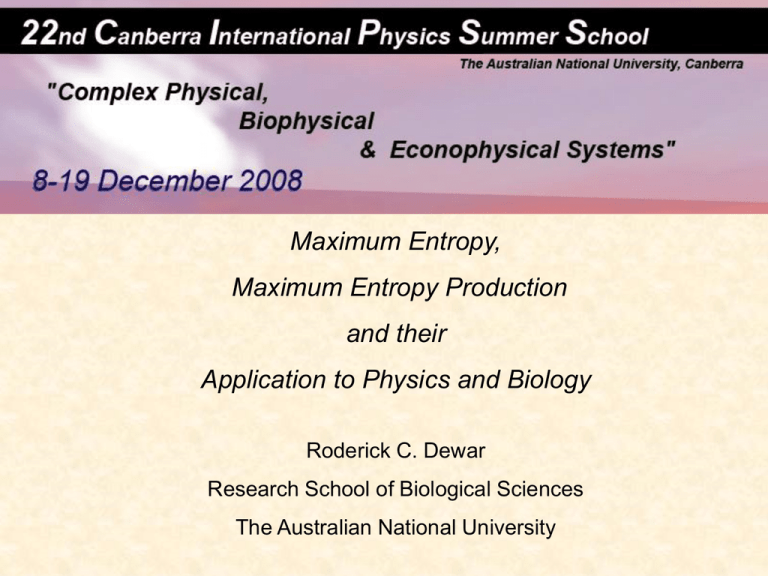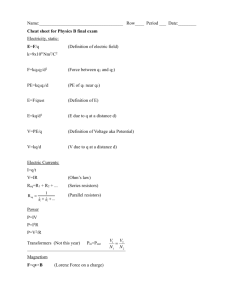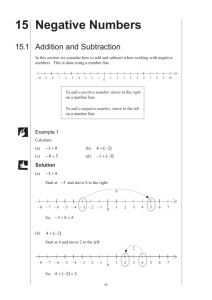Maximum Entropy and Maximum Entropy Production Principles and
advertisement

Maximum Entropy, Maximum Entropy Production and their Application to Physics and Biology Roderick C. Dewar Research School of Biological Sciences The Australian National University Recall Lecture 3 … Boltzmann MaxEnt applied to non-equilibrium systems : • maximum irreversibility Gibbs • steady-state flux selection by MEP • macroscopic dynamics Shannon Jaynes F0 max H max I FΩ uV Max H : H p pΓ log pΓ Subject to : Γ pΓ = 1 Γ pΓ fΓ = F Γ pΓuΓ = u uΓ /t = –fΓ + QΓ Γ τ pΓ exp Z path 2k B 1 normalisation flux Ω density V continuity equation 1 Q Γ f Γ V T T pΓ τ I ( p) p Γ log p~ k Γ B Γ (Dewar 2003) 1 Q τ F dS T T k B ΩT F V = entropy production in V = entropy export across Ω Max I: MEP Part 1: Maximum Entropy (MaxEnt) – an overview Part 2: Applying MaxEnt to ecology Part 3: Maximum Entropy Production (MEP) Part 4: Applying MEP to physics & biology MEP applications • Horizontal heat flows on Earth, Mars and Titan (Lorenz et al. 2001) • Horizontal heat flows and cloud cover on Earth (Paltridge 1975, 1978, 1981; O’Brien & Stephens 1993, 1995) • Ocean thermohaline circulation (Shimokawa & Ozawa 2002) • Rayleigh-Bénard convection (Malkus 1954) • Shear turbulence (Malkus 1956, Busse 1970) • Mantle convection (Lorenz 2002) • Crystal growth morphology (Hill 1990) • Energy dissipation in ecosystems (Schneider & Kay 1994) • Photosynthetic free energy transduction (Juretić et al. 2003) • Evolutionary optimisation of ATP synthase (Dewar et al. 2006) MEP applications • Horizontal heat flows on Earth, Mars and Titan (Lorenz et al. 2001) • Horizontal heat flows and cloud cover on Earth (Paltridge 1975, 1978, 1981; O’Brien & Stephens 1993, 1995) • Ocean thermohaline circulation (Shimokawa & Ozawa 2002) • Rayleigh-Bénard convection (Malkus 1954) • Shear turbulence (Malkus 1956, Busse 1970) • Mantle convection (Lorenz 2002) • Crystal growth morphology (Hill 1990) • Energy dissipation in ecosystems (Schneider & Kay 1994) • Photosynthetic free energy transduction (Juretić et al. 2003) • Evolutionary optimisation of ATP synthase (Dewar et al. 2006) Poleward heat transport 170 W m-2 Latitudinal heat transport H=? T 300 W m-2 SW LW cT24 Fsw cT14 Fsw=cT14+H Equatorial zone Polar zone H=? T1 1 1 EPmatter H T2 T1 T2 H = DΔT H=cT24 Trade-off between H and ΔT (Earth) 80 60 ΔT EP H DMEP = 1.4 40 DEarth ≈ 1.7 20 0 0.01 0.1 1 10 100 Inter-zonal thermal diffusivity D (W m-2 K-1) MEP works elsewhere T1 T0 T1 T0 EP EP MEP applications • Horizontal heat flows on Earth, Mars and Titan (Lorenz et al. 2001) • Horizontal heat flows and cloud cover on Earth (Paltridge 1975, 1978, 1981; O’Brien & Stephens 1993, 1995) • Ocean thermohaline circulation (Shimokawa & Ozawa 2002) • Rayleigh-Bénard convection (Malkus 1954) • Shear turbulence (Malkus 1956, Busse 1970) • Mantle convection (Lorenz 2002) • Crystal growth morphology (Hill 1990) • Energy dissipation in ecosystems (Schneider & Kay 1994) • Photosynthetic free energy transduction (Juretić et al. 2003) • Evolutionary optimisation of ATP synthase (Dewar et al. 2006) Paltridge (1978) : 10-zone climate model EPmatter 10 zonei 1 1 1 Fi Ti1 Ti EPradiation ? Planetary rotation rate ? N pole SWi LWi Equator S pole Fi Ti θi Zonal temperature and cloud cover Ti θi MEP applications • Horizontal heat flows on Earth, Mars and Titan (Lorenz et al. 2001) • Horizontal heat flows and cloud cover on Earth (Paltridge 1975, 1978, 1981; O’Brien & Stephens 1993, 1995) • Ocean thermohaline circulation (Shimokawa & Ozawa 2002) • Rayleigh-Bénard convection (Malkus 1954) • Shear turbulence (Malkus 1956, Busse 1970) • Mantle convection (Lorenz 2002) • Crystal growth morphology (Hill 1990) • Energy dissipation in ecosystems (Schneider & Kay 1994) • Photosynthetic free energy transduction (Juretić et al. 2003) • Evolutionary optimisation of ATP synthase (Dewar et al. 2006) Raleigh-Bénard convection: MEP = max flux (Ozawa et al 2001, after Malkus 1954) 1 1 F 1 Q EP F dS F F V T T ΩT Tc Th gαΔT d 3 Ra Ra * 1708 κν Cold plate, Tc diffusion d F is maximum when the boundary layer is marginally stable: δ convection 1 3 ΔT Ra Nu F / k d Ra * F diffusion Hot plate, Th=Tc+ΔT gαΔT 2δ 3 Ra b Ra * κν ΔT / 2 F Fb k δ δ M: slope = 1/3 (max flux) 1 1 F 1 Q EP F dS F F V T T ΩT Tc Th (max flux) Ozawa et al. (2001) after Malkus, Busse τΔU 1 Q 1 EP F Q τ T T T T V V M: slope = 1 M: slope = 1/3 (max flux) 1 1 F 1 Q EP F dS F F V T T ΩT Tc Th (max flux) Ozawa et al. (2001) after Malkus, Busse τΔU 1 Q 1 EP F Q τ T T T T V V M: slope = 1 Global entropy production (mW m-2 s-1) Tuning GCM parameters using MEP (Kleidon et al. 2006) total vertical horizontal k = 0.4 von Karman parameter, k MEP applications • Horizontal heat flows on Earth, Mars and Titan (Lorenz et al. 2001) • Horizontal heat flows and cloud cover on Earth (Paltridge 1975, 1978, 1981; O’Brien & Stephens 1993, 1995) • Ocean thermohaline circulation (Shimokawa & Ozawa 2002) • Rayleigh-Bénard convection (Malkus 1954) • Shear turbulence (Malkus 1956, Busse 1970) • Mantle convection (Lorenz 2002) • Crystal growth morphology (Hill 1990) • Energy dissipation in ecosystems (Schneider & Kay 1994) • Photosynthetic free energy transduction (Juretić et al. 2003) • Evolutionary optimisation of ATP synthase (Dewar et al. 2006) Different growth morphologies are labelled by their Miller indices <111>, <110> …... ….. the 3D orientations of the different crystal faces that are growing : <111> <110> Hill (1990) : crystallization of NH4Cl F = L (X - X0) EP<110> XMEP = 0.21 Xobs = 0.216 force X = liq - solid EP = F X flux F EP<111> MEP applications • Horizontal heat flows on Earth, Mars and Titan (Lorenz et al. 2001) • Horizontal heat flows and cloud cover on Earth (Paltridge 1975, 1978, 1981; O’Brien & Stephens 1993, 1995) • Ocean thermohaline circulation (Shimokawa & Ozawa 2002) • Rayleigh-Bénard convection (Malkus 1954) • Shear turbulence (Malkus 1956, Busse 1970) • Mantle convection (Lorenz 2002) • Crystal growth morphology (Hill 1990) • Energy dissipation in ecosystems (Schneider & Kay 1994) • Photosynthetic free energy transduction (Juretić et al. 2003) • Evolutionary optimisation of ATP synthase (Dewar et al. 2006) 2-state chlorophyll model: Juretić & Županović (2003) optimal quantum yield = 97% power transfer efficiency = 91% High efficiency ( 90%) is due to 5-state chlorophyll model: non-linear flux-force relation cf. linear flux-force relations: 50% power transfer efficiency optimal quantum yield = 94.6% power transfer efficiency = 87.8% MEP applications • Horizontal heat flows on Earth, Mars and Titan (Lorenz et al. 2001) • Horizontal heat flows and cloud cover on Earth (Paltridge 1975, 1978, 1981; O’Brien & Stephens 1993, 1995) • Ocean thermohaline circulation (Shimokawa & Ozawa 2002) • Rayleigh-Bénard convection (Malkus 1954) • Shear turbulence (Malkus 1956, Busse 1970) • Mantle convection (Lorenz 2002) • Crystal growth morphology (Hill 1990) • Energy dissipation in ecosystems (Schneider & Kay 1994) • Photosynthetic free energy transduction (Juretić et al. 2003) • Evolutionary optimisation of ATP synthase (Dewar et al. 2006) F0F1-ATP synthase : Nature’s smallest rotary motor pmf-driven H+ transport γ stalk torsion ATP synthesis Key functional parameter : κ = angular position of γ at which ADP+Pi ATP (motor timing) Transition rates between the 5 open (O) states of F1 were calculated using the kinetic model of Panke & Rumberg (1999) O: O:ATP JATP O:ADP O:ADP+Pi O:Pi Transition rates between the 5 open (O) states of F1 were calculated using the kinetic model of Panke & Rumberg (1999) O: O:ATP 5 S state pi log pi i 1 JATP O:ADP EPATP O:ADP+Pi J ATP RJ ATP log J ATP O:Pi MaxEnt predicts observed kinetic design of ATPase Sstate and EPATP : simultaneous maxima at κ = 0.598 XATP (102 J mol-1) JATP (s-1) (κempirical fit 0.6) Sstate (102) EPATP (10 J K-1 mol-1 s-1) Relative angular position of γ at which ADP+Pi ATP (κ) MaxEnt and MEP …what next? Theory • Boltzmann MaxEnt basis of MEP : info theory vs. max probability (N ) Applications in Global Change Science and beyond …. Gibbs Shannon • Climate and climate change : EPwater, cloud & water vapour feedbacks • Plant and ecosystem responses to climate change : MEP = plant optimisation (“survival of the likeliest”) • Climate-biosphere feedbacks : MEP = Gaia for grown-ups • Other complex, non-equilibrium systems : e.g. plasmas, economies, networks Annual MEP Workshops • Jaynes Bordeaux (2003-05), Split (2006), Jena (2007-09) ….





